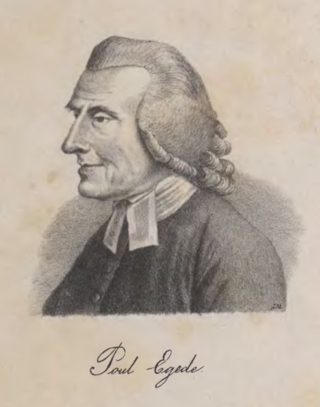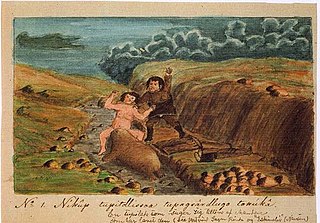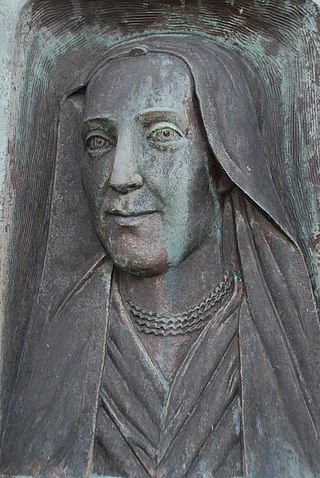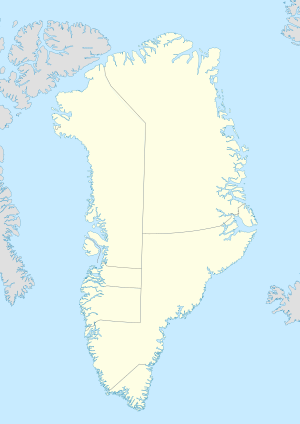
Greenland is an island country in North America that is part of the Kingdom of Denmark. It is located between the Arctic and Atlantic oceans, east of the Canadian Arctic Archipelago. Greenland is the world's largest island. It is one of three constituent countries that form the Kingdom of Denmark, along with Denmark and the Faroe Islands; the citizens of these countries are all citizens of Denmark and the European Union. Greenland's capital is Nuuk.

This is a demography of the population of Greenland including population density, ethnicity, economic status, religious affiliations and other aspects of the population.

The history of Greenland is a history of life under extreme Arctic conditions: currently, an ice sheet covers about eighty percent of the island, restricting human activity largely to the coasts.

Denmark and the former real union of Denmark–Norway had a colonial empire from the 17th through the 20th centuries, large portions of which were found in the Americas. Denmark and Norway in one form or another also maintained land claims in Greenland since the 13th century, the former up through the twenty-first century.

Nuuk is the capital and largest city of Greenland, a constituent country of the Kingdom of Denmark. Nuuk is the seat of government and the country's largest cultural and economic centre. The major cities from other countries closest to the capital are Iqaluit and St. John's in Canada and Reykjavík in Iceland. Nuuk contains a third of Greenland's population and its tallest building. Nuuk is also the seat of government for the Sermersooq municipality. In January 2021, it had a population of 18,800.

Hans Poulsen Egede was a Dano-Norwegian Lutheran missionary who launched mission efforts to Greenland, which led him to be styled the Apostle of Greenland. He established a successful mission among the Inuit and is credited with revitalizing Dano-Norwegian interest in the island after contact had been broken for about 300 years. He founded Greenland's capital Godthåb, now known as Nuuk.

Paul or Poul Hansen Egede was a Dano-Norwegian theologian, missionary, and scholar who was principally concerned with the Lutheran mission among the Kalaallit people in Greenland that had been established by his father, Hans, in 1721.

Erik the Red's Land was the name given by Norwegians to an area on the coast of eastern Greenland occupied by Norway in the early 1930s. It was named after Erik the Red, the founder of the first Norse or Viking settlements in Greenland in the 10th century. The Permanent Court of International Justice ruled against Norway in 1933, and the country subsequently abandoned its claims.

Aron of Kangeq was a Greenlandic Inuit hunter, painter, and oral historian. His woodcuts and watercolors are noted for their depiction of Inuit culture and history, and the often violent encounters between Inuit and Danish colonizers. His storytelling is known to children's literature in Greenland.
Count Eigil Knuth was a Danish explorer, archaeologist, sculptor and writer. He is referred to as the Nestor of Danish polar explorers. His archaeological investigations were made in Peary Land and adjacent areas of High Arctic Greenland. Knuth was made a Knight of the Dannebrog.

Gertrud Rask was the first wife of the Danish-Norwegian missionary to Greenland Hans Egede and was the mother of the missionary and translator Paul Egede.

Old Nuuk may refer to several neighborhoods of Nuuk, the capital of Greenland.

Dr. Hinrich Johannes Rink was a Danish geologist, one of the pioneers of glaciology, and the first accurate describer of the inland ice of Greenland. Rink, who first came to Greenland in 1848, spent 16 winters and 22 summers in the Arctic region, and became notable for Greenland's development. Becoming a Greenlandic scholar and administrator, he served as Royal Inspector of South Greenland and went on to become Director of the Royal Greenland Trading Department. With "Forstanderskaber", Rink introduced the first steps towards Greelandic home rule.
Nipisat Island is a small, uninhabited island in the Qeqqata municipality in central-western Greenland.
Major Claus Enevold Paarss was a Danish military officer and official. Retired from service, he was appointed governor of Greenland by King Frederick IV between 1728 and 1730.

The Moravian missions in Greenland were established by the Moravian Church or United Brethren and operated between 1733 and 1900. They were operated under the auspices of the Royal Danish College of Missions until its dissolution in 1859 and were finally surrendered to the Lutheran Church of Denmark in 1900. Missionaries were allocated to the region and sometimes even sent wives who had been chosen for them and approved by the drawing of lots, a form of Cleromancy.
The Bergen Greenland Company or Bergen Company (Bergenkompagniet) was a Dano-Norwegian private corporation charged with founding and administering Danish-Norwegian colonies and trade in Greenland, as well as searching for any survivors from the former Norse settlements on the island. It operated from 1721 until its bankruptcy in 1727. Although the Bergen Company failed as a concern and both its settlements were destroyed and abandoned, it was ultimately successful in re-establishing sovereignty over Greenland.
















